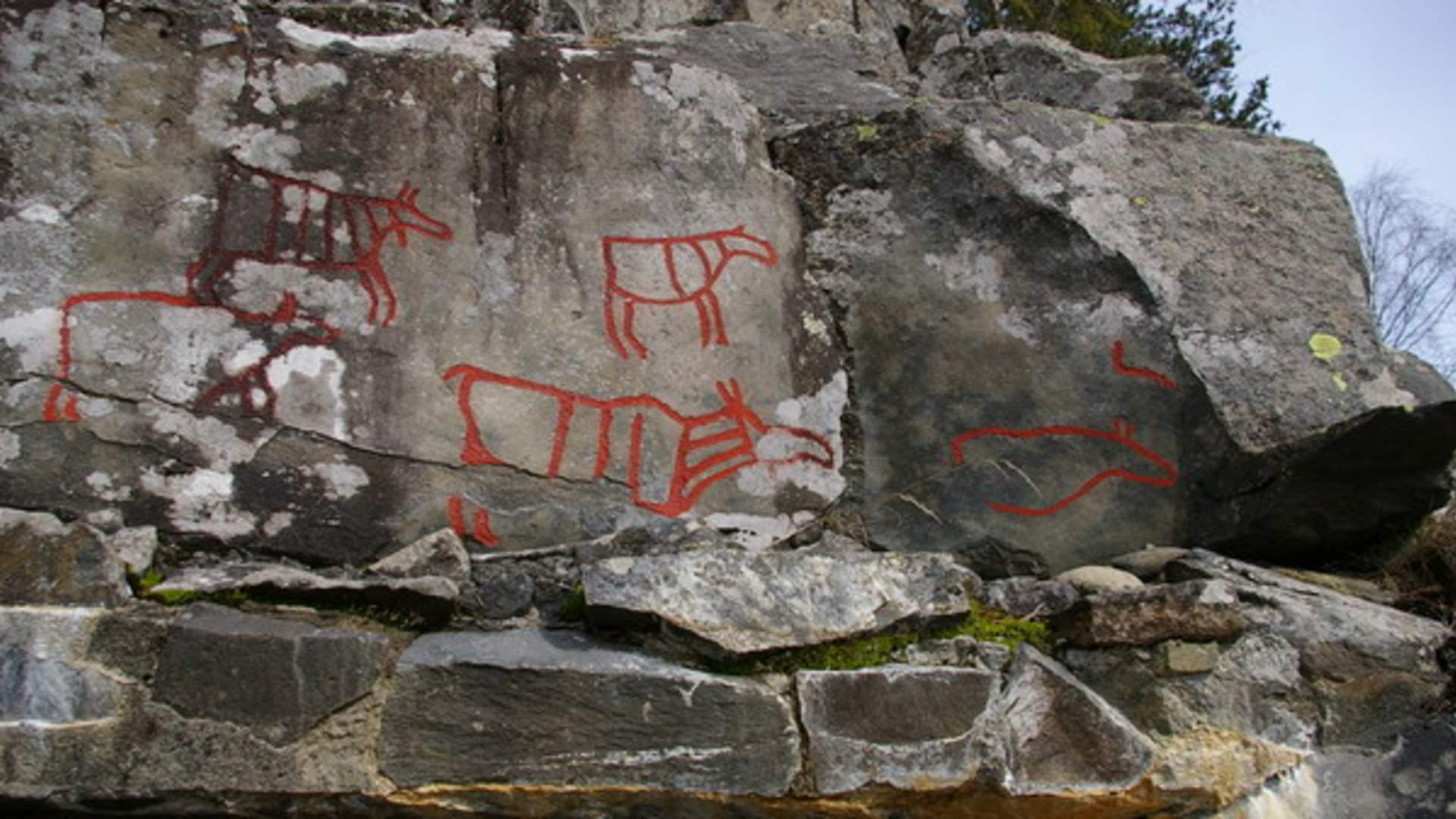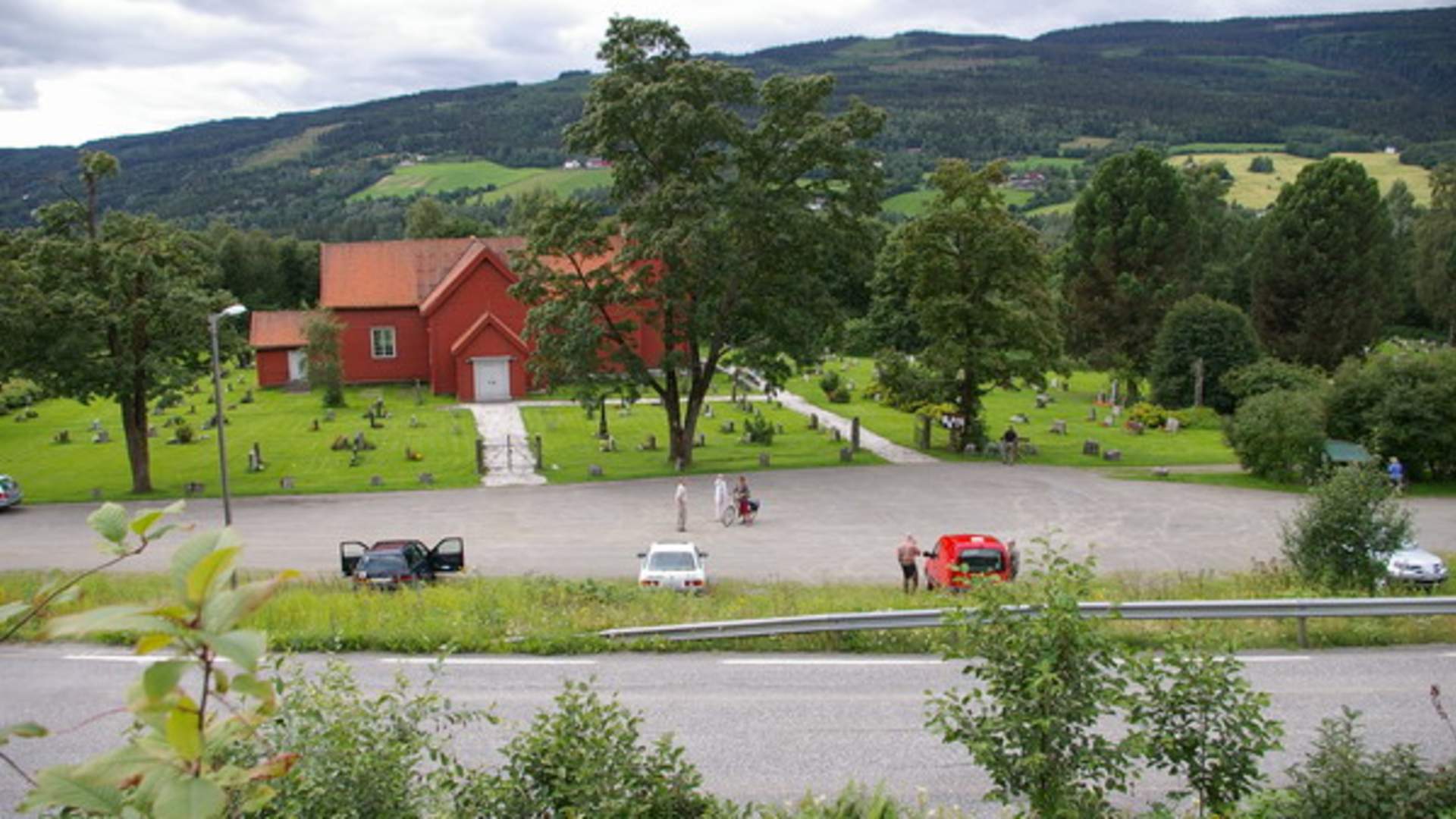Lillehammer
Fåberg Cultural Trail



Fåberg cultural trail is a 4 km walk leading from Fåberg Church to the petroglyphs by Drotten. Gentle terrain with picturesque hamlets and spectacular views. The trail is well marked.
Arceological findings indicate that these farms are older than, what is indicated by the name Jørstad, the Viking age. 25 cooking places from the Iron Age have been found. The old meetingplace where farmers used to gather to settle disputes became the centre of the region.
Rock engraving at Drotten. (inaccessible during spring flooding). Rock engraving may be seen at the water edge of the river Lågen. 7 elks (U.S.: moose) are carved on the mountain wall at a point where elks used to, and still do, cross.
Fåberg church The stave church from the Middle Ages was torn down and replaced with the present church in 1723. The front in soapstone and the church bells are amongst the oldest items in the church, 1100. In the porch is a gravestone from 1202. In 1954 a restoration found place. A grave for trapping wolves i found west of the church.
"Storfossen" July 1789 a natural disaster took place in the Gudbrandsdals valley and Lillehammer in Norway. During summer, there were exceptional heavy rains. Rivers and creeks flooded and the top soil slid down the sides of the valleys. Houses, trees and animals were taken. Many people were killed. The landscape changed, and it affected fishing in the rivers for tens of years after.
The Rune Stone at Fåberg church from the Viking Period, possibly 1000 years old. Inscription: "Roar erected this Stone in Memory of Olve, his Fahter."
Burial Mounds at Lillehammer in Norway are difficult to date. The one next to this path is between 1000-2000 years old. Porbably a chieftain was buried here. It has never been opened, and we do not know what is hidden within it. However some mounds contain large numbers of weapons, valuable objects and ordinary household implements which the dead would need in his next life.
Fishing for "Lågåsild" The small type of salmon is a great importance to the people in Fåberg as it returns in large numbers up the river Lågen from Lake Mjøsa in autumn every year. One of the 80 good fishing places could be as valuable as a medium-sized farm! In the 1960s people fished 136 tons each year.
Crofts The population explosion in the 19th century resulted in increased numbers of cotters. 87 crofts were connected to the farms along this path only. Additional land division became difficult; for many emigration became the only solution. As the crofts were small, many cotters had to take extra work as craftsmen to survive.
View from Jørstadhøgda North of Lake Mjøsa at Lillehammer in Norway we see the host city of the Winter Olympic Games 1994. The ski jumping area can be seen to north east of the town. Below the hill Balbergkampen the regional college "Lillehammer College" may be seen.On top of the hill a fire would be lit in times of war. The river delta became a protected area in 1990. 197 species of birds are found here. The river is abounding in fish.
Elms The leaves and young branches were used to feed the animals during winter. The bark was used for bread in times of need..
The farms today. The farms are more specialized today. Fishing, which used to provide a handsome additional income, is now merely a hobby. In the 19th century 20 crofts were connected to fram of S.Jørstad and as many to Øvre Dal. In addition there was many farmhands, both men and women, on the farms. Today all work on the farms is done by family members only..
Rock engraving at Drotten. (inaccessible during spring flooding). Rock engraving may be seen at the water edge of the river Lågen. 7 elks (U.S.: moose) are carved on the mountain wall at a point where elks used to, and still do, cross.
Fåberg church The stave church from the Middle Ages was torn down and replaced with the present church in 1723. The front in soapstone and the church bells are amongst the oldest items in the church, 1100. In the porch is a gravestone from 1202. In 1954 a restoration found place. A grave for trapping wolves i found west of the church.
"Storfossen" July 1789 a natural disaster took place in the Gudbrandsdals valley and Lillehammer in Norway. During summer, there were exceptional heavy rains. Rivers and creeks flooded and the top soil slid down the sides of the valleys. Houses, trees and animals were taken. Many people were killed. The landscape changed, and it affected fishing in the rivers for tens of years after.
The Rune Stone at Fåberg church from the Viking Period, possibly 1000 years old. Inscription: "Roar erected this Stone in Memory of Olve, his Fahter."
Burial Mounds at Lillehammer in Norway are difficult to date. The one next to this path is between 1000-2000 years old. Porbably a chieftain was buried here. It has never been opened, and we do not know what is hidden within it. However some mounds contain large numbers of weapons, valuable objects and ordinary household implements which the dead would need in his next life.
Fishing for "Lågåsild" The small type of salmon is a great importance to the people in Fåberg as it returns in large numbers up the river Lågen from Lake Mjøsa in autumn every year. One of the 80 good fishing places could be as valuable as a medium-sized farm! In the 1960s people fished 136 tons each year.
Crofts The population explosion in the 19th century resulted in increased numbers of cotters. 87 crofts were connected to the farms along this path only. Additional land division became difficult; for many emigration became the only solution. As the crofts were small, many cotters had to take extra work as craftsmen to survive.
View from Jørstadhøgda North of Lake Mjøsa at Lillehammer in Norway we see the host city of the Winter Olympic Games 1994. The ski jumping area can be seen to north east of the town. Below the hill Balbergkampen the regional college "Lillehammer College" may be seen.On top of the hill a fire would be lit in times of war. The river delta became a protected area in 1990. 197 species of birds are found here. The river is abounding in fish.
Elms The leaves and young branches were used to feed the animals during winter. The bark was used for bread in times of need..
The farms today. The farms are more specialized today. Fishing, which used to provide a handsome additional income, is now merely a hobby. In the 19th century 20 crofts were connected to fram of S.Jørstad and as many to Øvre Dal. In addition there was many farmhands, both men and women, on the farms. Today all work on the farms is done by family members only..
Source: Visit Lillehammer
Fåberg Cultural Trail